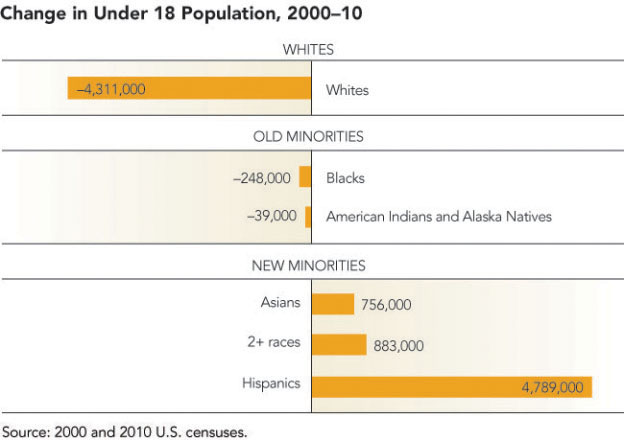Five Charts That Show Why a Post-White America Is Already Here
William H. Frey, New Republic, November 21, 2014
The sweeping racial changes transforming the United States come with an important demographic dimension: age. The waves of Hispanics and Asians and multiracial Americans reshaping the country’s population are full of young people, who by some measures already outnumber their white counterparts. The trend was punctuated by the arrival in 2011 of the first “majority-minority” birth cohort, the first in which the majority of U.S. babies were nonwhite minorities. Consequently, the racial makeup of the nation’s younger population is beginning to contrast sharply with that of baby boomers and seniors.
{snip}
{snip} From 2000 to 2010, a decade during which the white population as a whole grew by just 1.2 percent, the number of white children in the United States declined by 4.3 million. Meanwhile the child populations of Hispanics, Asians, and people of two or more races were increasing. In comparative terms, whites constituted just 53 percent of America’s young people (down from nearly 70 percent in 1990) while Hispanics constituted 23 percent (up from just 12 percent). Smaller white populations already are evident in institutions that serve youth, such as elementary and secondary schools, and census projections show the white child population continuing to decline for years to come. White children will become a minority of children under age 18 well before 2020, and, soon thereafter, the white population as a whole is projected to begin to decrease.
For most of the lifetime of today’s young people–nearly one-half of whom already are members of racial minorities–America’s white population will be shrinking.
The reason for the divergence is straightforward: In the white population, there will be fewer births than deaths, and nowhere near enough whites emigrating to the United States to make up the difference. {snip}
One corrolary to these shifts is that the white population is aging more rapidly than that of other racial groups. The 2010 census indicated that the median age for whites was 42 years. For Asians, it was 35.4. For Hispanics, it was 27.3. And for the population marking “more than once race,” it was a staggering 19.9. Overall, just 7 percent of the minority population was age 65 or older, while 16 percent of the white population had already reached that milestone. In the years to come, the slowly growing white population will begin an accelerated aging process, while higher fertility and immigration rates mean that the minority population will not age nearly as rapidly. By 2030, approximately 26 percent of the nation’s whites but just 13 percent of minorities will be seniors.
{snip}
The diversification of the U.S. population from the bottom holds more than just demographic significance. It reflects an emerging cultural divide between the young and the old as they adapt to change in different ways.
The cultural generation gap can be linked partly to the sharp racial distinctions between the baby boomers–who are mostly over the age of 50–and their elders, on one hand, and, on the other, the younger generations: the millennial generation and young members of generation X and their children, who constitute the population under the age of 35. Baby boomers and seniors are more than 70 percent white. In contrast, millennials and young generation Xers and their children are more than 40 percent minority. At the extremes of the age spectrum, the differences are even more pronounced: As of 2010, slightly more than one-half of children under age five were white; in contrast, the oldest age group was 85 percent white.
{snip}
The cultural divide opening between the older, whiter and younger, more diverse generations will require adaptation on all sides, and policymakers and citizens alike will need to approach these changes with a long view. Rather than seeing the inevitable changes as damaging to the American way of life, it behooves the nation to consider the future, and prepare now for a country that will be majority-minority.

















